
|
Today's Calendar |
| | Simply Economics |
| | International Perspective |
| | Resource Center |
 |
|
| 1999 Articles |
|
By Evelina M. Tainer Chief Economist, Econoday Strong growth with stable wages help boost investor confidence
(Another) exciting week for equities 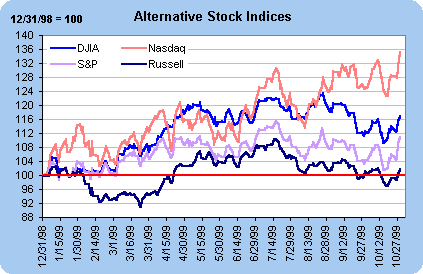 Dow Jones & Company announced a revision to the 30 industrial stocks. Effective with Monday's trading, Intel, Microsoft, Home Depot and SBC Communications will join the ranks of the Dow Industrials. Chevron, Goodyear, Sears and Union Carbide are out. It will be interesting to see if the composition shift gives renewed vigor to this index.
Treasury market rallies on economic data and Greenspan comments 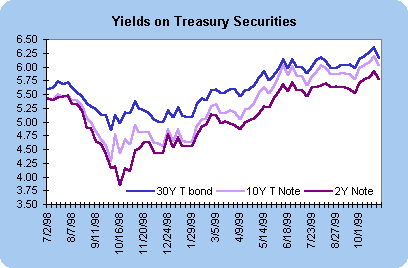
3Q GDP growth as expected; history revised higher  Household investment in housing also slowed. Indeed, residential investment expenditures declined at a 6.3 percent rate in the third quarter after growing at an average 9.2 percent rate in the first half of the year. The drop in housing activity may be related to the moderation in durable goods spending. Housing demand creates greater interest in spending on furniture and appliances. As the demand for housing lessens, so does the demand for household furnishings. Expenditures on business fixed investment expanded at a 14.9 percent rate - curtailed by a drop in nonresidential structures. That means that producers' durable equipment grew at a whopping 21.7 percent rate. Incidentally, the government redefined this category to include expenditures on computer software. The inclusion of software to the GDP accounts as investment rather than secondary inputs caused the history of the series (investment and total GDP) to be revised higher - particularly in the 1990s. Inventory building also contributed to third quarter GDP growth after acting as a significant drag in the previous quarter. The inventory build-up is not unexpected in light of potential disruptions that may be caused by the ubiquitous Y2K bug. Most analysts expect that real GDP growth will be curtailed dramatically in the first half of 2000 as inventories are run down. Net exports widened in the third quarter, but to a lesser extent than the previous quarter. Although real imports surged 17 percent for the period, export demand jumped 12.4 percent. This was the largest quarterly increase in exports since the second quarter of 1997, and reflects recoveries in Asia and accelerating expansions in Europe. Government expenditures also helped to propel growth this past quarter. It isn't unusual to see a surge in national defense expenditures in the third quarter as appropriations run off at the end of the government's fiscal year. It happened last year too. This should be seasonally adjusted, but can't always be captured by the seasonal factor. The bottom-line on growth? Real GDP came in line with expectations. Some of the growth is related to the problems surrounding the turn of the millenium. More interesting perhaps than the most recent quarterly figures are the upward revisions to the history of the series. Trend growth is now estimated at 3 percent rather than 2.8 percent. The 0.2 percentage points appears inconsequential but actually represents 0.2 percentage points PER YEAR which adds up with respect to the economic pie. The greater funds spent on investment also means that productivity grew more rapidly over the past several years than was previously estimated. (We won't see actual data until the Labor Department reports the revised figures.) Nobel prize-winning economist Robert Solow estimates that average productivity growth of 1 percent a year allows an economy to double its standard of living in 72 years. When productivity gains average 2 percent a year, the standard of living doubles in 36 years!
Stable employment cost index reassures investors 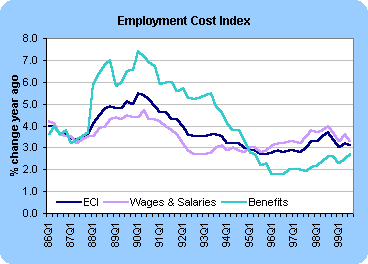 Ever since Fed chairman Alan Greenspan noted his interest in this index a few years ago, it has become a major market mover. Even yesterday, the combination of this stable report coupled with the moderation in the GDP price deflator (from 1.3 percent in the second quarter to 1 percent in the third quarter) helped stage major rallies in the bond and equity markets. The bottom-line on compensation costs? The stability of compensation costs is astounding given the high degree of tightness in the labor markets. Some analysts might suggest that the employment cost index doesn't reflect true compensation costs as more employers are offering stock options to a wider number of employees (not just executives). Yet, neither these figures nor the GDP deflator suggest that inflation is a near term problem.
Durable goods falter after four month run 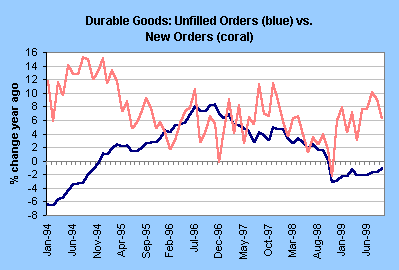 The bottom-line on manufacturing activity? Although new orders for durable goods declined in September, the sector is showing more strength these past several months versus late 1998 and early this year. Strength may have carried over into the fourth quarter. The Chicago purchasing managers' index gained five points to 58.8 in October. The index fluctuates more wildly than the NAPM, but often moves in the same direction.
Home sales take a dive 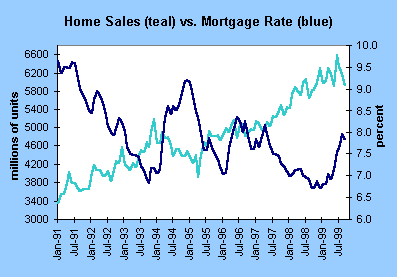 Since the beginning of this year, mortgage rates have risen nearly 150 basis points. Even though healthy income gains and a booming stock market helped to boost housing activity earlier this year, the rising rate environment was bound to curtail housing activity eventually. Indeed, addressing the Business Council Thursday evening, Fed chairman Alan Greenspan noted that the summer's rate hikes were beginning to have an impact on economic activity. Furthermore, he noted that rising interest rates induced by supply and demand forces would also hamper growth. The bottom line on housing? Housing starts and home sales probably peaked in this past summer. As we go forward, higher mortgage rates will reduce the rate of growth. Moreover, this slowdown will also extend to consumer spending on furniture and appliances.
THE BOTTOM LINE Despite the stability in the employment cost index and the slower rate of inflation measured by the GDP deflator, not all economists and policy-makers (including Fed chairman Alan Greenspan) are willing to concede that inflation has been completely eradicated. While Greenspan did suggest that "faster productivity growth keeps a lid on unit costs and prices," he also is worried that the current pace won't be sustained or reign in consumer demand. Wall Street economists continue to debate whether the Fed will raise rates, or not, at the November 16 FOMC meeting. No one is debating whether the employment situation, reported next Friday, will make a difference. Investors' eyes will be glued to their screens.
Looking Ahead: Week of November 1 to 5
Monday Construction expenditures are expected to decrease 0.3 percent in September in line with the past several months. As housing activity simmers down in coming months, so will construction expenditures.
Tuesday
Wednesday The index of leading indicators is expected to remain unchanged in September. This index is going nowhere and doesn't reflect any real changes in the economy. All eyes will turn to the Beige Book proceeding the November 16 FOMC meeting. Market players would like the Beige Book to reveal that consumer demand is waning; housing activity is moderating; labor market is less constrained and prices and wages are stable. The question is: will they?
Thursday
Friday Consumer installment credit is expected to rise $7 billion in September after a whopping $10.8 billion gain in August. This should come from softer retail spending - particularly on cars and trucks. |
|||||||||||||||||||||||||||||||||||||||||||||||||||||||||||||||||||||||||||||||||||||||||||